Related Research Articles
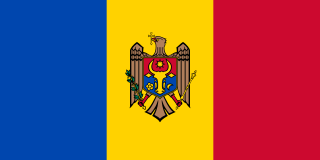
Moldova, officially the Republic of Moldova, is a country in Eastern Europe. It is bordered by Romania to the west and Ukraine to the north, east, and south. The unrecognised breakaway region of Transnistria lies across the Dniester on the country's eastern border with Ukraine. Moldova's capital and largest city is Chișinău.
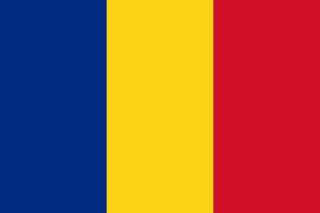
Romania is a country located at the crossroads of Central, Eastern, and Southeastern Europe. It borders Bulgaria to the south, Ukraine to the north, Hungary to the west, Serbia to the southwest, Moldova to the east, and the Black Sea to the southeast. It has a predominantly temperate-continental climate, and an area of 238,397 km2 (92,046 sq mi), with a population of around 19 million. Romania is the twelfth-largest country in Europe and the sixth-most populous member state of the European Union. Its capital and largest city is Bucharest, and other major urban areas include Iași, Cluj-Napoca, Timișoara, Constanța, Craiova, Brașov, and Galați.

Romanian is an Eastern Romance language spoken by approximately 22–26 million people as a native language, primarily in Romania and Moldova, and by another 4 million people as a second language. According to another estimate, there are about 34 million people worldwide who can speak Romanian, of whom 30 million speak it as a native language. It is an official and national language of both Romania and Moldova and is one of the official languages of the European Union.
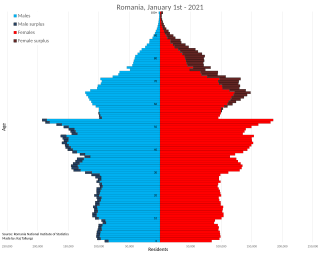
This article is about the demographic features of the population of Romania, including population density, ethnicity, education level, health of the populace, economic status, religious affiliations, and other aspects of the population.

The foreign relations of Romania are conducted by the Ministry of Foreign Affairs. Romania is a member of NATO and the European Union.
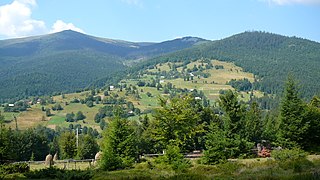
Transylvania is a historical region in central Romania. To the east and south its natural border is the Carpathian Mountains, and to the west the Apuseni Mountains. Broader definitions of Transylvania also encompass the western and north-western Romanian regions Crișana and Maramureș, and occasionally Banat.

The Warsaw Treaty Organization (WTO), officially the Treaty of Friendship, Cooperation and Mutual Assistance, commonly known as the Warsaw Pact (WP), was a collective defense treaty signed in Warsaw, Poland, between the Soviet Union and seven other Eastern Bloc socialist republics of Central and Eastern Europe in May 1955, during the Cold War. The Warsaw Pact was the military complement to the Council for Mutual Economic Assistance (CoMEcon), the regional economic organization for the socialist states of Central and Eastern Europe. The Warsaw Pact was created in reaction to the integration of West Germany into NATO in 1955 as per the London and Paris Conferences of 1954.

Bucharest is the capital and largest city of Romania, as well as its cultural, industrial, and financial centre. It is located in the southeast of the country, on the banks of the Dâmbovița River, less than 60 km (37.3 mi) north of the Danube River and the Bulgarian border.

The Carpathian Mountains or Carpathians are a range of mountains forming an arc across Central and Eastern Europe. Roughly 1,500 km (930 mi) long, it is the third-longest European mountain range after the Urals at 2,500 km (1,600 mi) and the Scandinavian Mountains at 1,700 km (1,100 mi). The range stretches from the far eastern Czech Republic (3%) and Austria (1%) in the northwest through Slovakia (17%), Poland (10%), Hungary (4%), Ukraine (10%), Romania (50%) to Serbia (5%) in the south. The highest range within the Carpathians is known as the Tatra mountains in Slovakia and Poland, where the highest peaks exceed 2,600 m (8,500 ft). The second-highest range is the Southern Carpathians in Romania, where the highest peaks range between 2,500 m (8,200 ft) and 2,550 m (8,370 ft).

Chișinău is the capital and largest city of the Republic of Moldova. The city is Moldova's main industrial and commercial center, and is located in the middle of the country, on the river Bâc, a tributary of the Dniester. According to the results of the 2014 census, the city proper had a population of 532,513, while the population of the Municipality of Chișinău was 700,000. Chișinău is the most economically prosperous locality in Moldova and its largest transportation hub. Nearly a third of Moldova's population lives in the metro area.

Timișoara is the capital city of Timiș County and the main economic, social and cultural center in western Romania. Located on the Bega River, Timișoara is considered the informal capital city of the historical Banat, which is nowadays broadly considered a subregion of Transylvania. From 1848 to 1860 it was the capital of the Serbian Vojvodina and the Voivodeship of Serbia and Banat of Temeschwar. With 319,279 inhabitants at the 2011 census, Timișoara was then the country's third most populous city, after Bucharest and Cluj-Napoca. It is home to almost half a million inhabitants in its metropolitan area, while the Timișoara–Arad conurbation concentrates more than 70% of the population of Timiș and Arad counties. Timișoara is a multicultural city, being the home of 21 different ethnicities and 18 religions. Interculturality has long been a special characteristic for the western part of the country.

Cluj-Napoca, or simply Cluj, is the fourth-most populous city in Romania. It is the seat of Cluj County in the northwestern part of the country. Geographically, it is roughly equidistant from Bucharest, Budapest and Belgrade. Located in the Someșul Mic river valley, the city is considered the unofficial capital of the historical province of Transylvania. From 1790 to 1848 and from 1861 to 1867, it was the official capital of the Grand Principality of Transylvania.

Bukovina is a historical region, variously described as part of either Central or Eastern Europe. The region is located on the northern slopes of the central Eastern Carpathians and the adjoining plains, today divided between Romania and Ukraine.
Moldovan, also known historically as Moldavian, is one of the two local names of the Romanian language in Moldova. "Moldovan" is declared the official language in Article 13 of the constitution adopted in 1994, while the 1991 Declaration of Independence of Moldova uses the name "Romanian". In 2003, the Moldovan parliament adopted a law defining "Moldovan" and "Romanian" as glottonyms for the same language. In 2013, the Constitutional Court of Moldova interpreted that Article 13 of the constitution is superseded by the Declaration of Independence, thus giving official status to the name "Romanian." The breakaway region of Transnistria continues to recognize "Moldovan" as one of its official languages, alongside Russian and Ukrainian.

The Romanians are a Romance-speaking ethnic group. Sharing a common Romanian culture and ancestry, and speaking the Romanian language, they live primarily in Romania and Moldova. The 2011 Romanian census found that just under 89% of Romania's citizens identified themselves as ethnic Romanians.

The term Greater Romania usually refers to the borders of the Kingdom of Romania in the interwar period, achieved after the Great Union. It also refers to a pan-nationalist idea.

The Romanian diaspora is the ethnically Romanian population outside Romania and Moldova. The concept does not usually include the ethnic Romanians who live as natives in nearby states, chiefly those Romanians who live in Ukraine and Serbia. Therefore, the number of all Romanians abroad is estimated at about 4–12 million people, depending on one's definition of the term "Romanian" as well as the inclusion respectively exclusion of ethnic Romanians living in nearby countries where they are indigenous. The definition of "who is a Romanian?" may range from rigorous conservative estimates based on self-identification and official statistics to estimates that include people of Romanian ancestry born in their respective countries as well as people born to various ethnic-minorities from Romania.
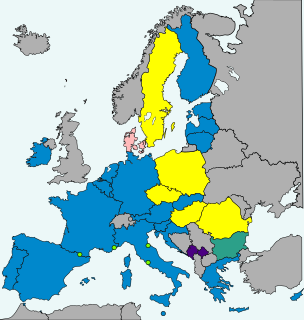
Romania's national currency is the leu. After Romania joined the European Union (EU) in 2007, the country became required to replace the leu with the euro once it meets all four euro convergence criteria, as stated in article 140 of the Treaty on the Functioning of the European Union. As of 2022, the only currency on the market is the leu and the euro is not yet used in shops. The Romanian leu is not part of the European Exchange Rate Mechanism, although Romanian authorities are working to prepare the changeover to the euro. To achieve the currency changeover, Romania must undergo at least two years of stability within the limits of the convergence criteria. The current Romanian government established a self-imposed criterion to reach a certain level of real convergence as a steering anchor to decide the appropriate target year for ERM II membership and Euro adoption. In March 2018, the National Plan for the Adoption of the Euro scheduled the date for euro adoption in Romania as 2024. Nevertheless, in early 2021, this date was postponed to 2027 or 2028, and once again to 2029 in late 2021.

The Danube is the second-longest river in Europe, after the Volga in Russia. It flows through much of Central and Southeastern Europe, from the Black Forest into the Black Sea. Its longest headstream Breg rises in Furtwangen im Schwarzwald, while the river carries its name from its source confluence in Donaueschingen onwards.

A total of 41 counties, along with the municipality of Bucharest, constitute the official administrative divisions of Romania. They represent the country's NUTS-3 statistical subdivisions within the European Union and each of them serves as the local level of government within its borders. Most counties are named after a major river, while some are named after notable cities within them, such as the county seat.
References
- ↑ "THE ADMINISTRATION AND THE ELECTORAL PROCESS IN ROMANIA DURING PARLIAMENTARY DEMOCRACY (1919-1937)" (PDF). Archived from the original (PDF) on 2012-04-25. Retrieved 2011-12-27.